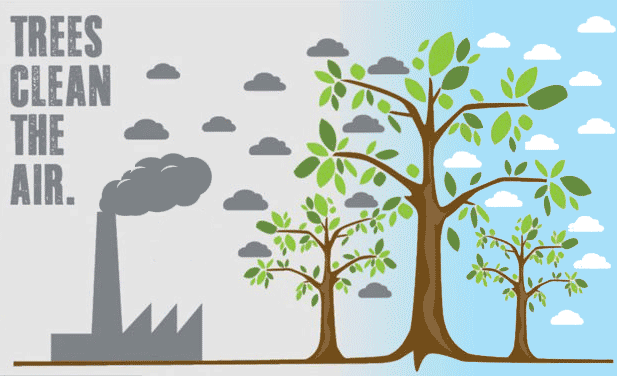Pollution on the planet is increasing every day, especially by daily urban activity. Luckily, trees provide natural remedies for some of this pollution and harmful gases.
Trees do improve the air quality by helping to purify the air we breathe. They complete a perfect cycle that helps to reverse some of the harmful damage we are doing to the planet.
Trees require photosynthesis to generate their nutrients. This process takes Co2 from the air to produce their “food”, and by taking the carbon, they release the remaining oxygen to their surroundings.

Trees help clean the environment by absorbing the polluting gases from the atmosphere and purifying it.
Trees are able to clean the air by reducing two types of pollutants, both gaseous pollutants and airborne particles. Gaseous pollutants include a range of dioxides such as sulfur and nitrogen. Airborne particles would be inhaled deep into our lungs if trees did not absorb them.
Many of these agents are toxic to humans, yet they are beneficial to plants as nutrition. Examples of these are nitrogen and sulfur, essential elements for fertilizers. The leaves of trees have pockets, known as Stomata, which filter in these matters and expel oxygen.
The emission of pure oxygen from the trees helps to lower the temperature in the environment. Trees not only clean the urban air, but they also help slow down global warming by removing excess carbon from the atmosphere.

How do trees produce oxygen?
In the origin of life, trees had a significant impact on the evolutionary phase. Thanks to trees, the atmospheric conditions were suitable for life because of their capacity to produce clean oxygen.
The photosynthesis process takes place inside the leaves of the trees, and this process is what keeps the air fresh.
Trees convert carbon dioxide (Co2) into oxygen through a process known as photosynthesis. During this process, the leaves of the tree absorb environmental gases such as carbon dioxide and nitrogen. Once absorbed, the gases mix with the water inside the plant and as a result, the water becomes oxidized.
What is left inside the plants is H20, pure and without toxic agents. The water molecules inside the plants are broken down thanks to the UV rays of the sun. They then evaporate. The resulting gas is clean, pure oxygen for mammals and other animals.

How much Co2 do trees absorb?
Certain tree characteristics determine the amount of carbon dioxide it can ingest. The first thing is the size of the tree; larger trees tend to absorb more carbon dioxide. The amount of leaves in the tree is another factor to consider, as they’re where oxygen production takes place.
According to extensive studies, the best trees for oxygen production are pines.
They absorb about 48 tons of carbon dioxide per hectare per year. On the other hand, Oak trees absorb about half that at 27 tons. The amount consumed by one of these trees is equivalent to the carbon dioxide emitted by over 1,000 vehicles.
Others are not as effective, such as Elms, Acacias and Jacarandas. An Elm can absorb 132 cars, 161 for Acacias, and Jacarandas 141 cars.
Benefits of trees:
Production of oxygen for life
As detailed in this article, trees provide us with oxygen that is vital for the survival of everything. They are an essential part of symbiosis; we produce the Co2 that they need and they produce the oxygen that all animal life depends on for survival.
Fruit for a healthy diet
Trees produce an essential food group for most mammals. The fruit they provide contains vitamins, minerals and healthy sugars for the development of the body. Another quality of the fruit is that it protects the body at a cellular level from external toxic agents, therefore acting as an antioxidant.
An adequate temperature
Global warming is a critical topic for everyone. Excess contamination and the lack of trees are causing the temperature to rise. By increasing the number of trees, we can diminish the effects of global warming and progressively restore the Ozone layer.
Reduced heat island effect
On a more microclimatic scale, having a good canopy cover in any city has proven to reduce temperatures by 5 – 10 degrees Celsius in summer. This also reduces the need for air-conditioning for residents, further reducing the amount of Co2 produced by humans.
Pleasant appearance
Trees are one of the most beautiful natural decorations on Earth. They create unique landscapes and an incredibly relaxing environment.
An intrinsic element for the production of food groups
Plants not only produce food for the sustenance of different animal species, but they also enable people to produce other types of food. Honey is an example; the pollen from the flowers makes it possible for bees to produce honey.
Wildlife refuge
Most animals have an essential role in nature. Animals such as monkeys, birds, squirrels and others, use trees as housing. An imbalance in the ecosystem can cause the extinction of a species or the invasion of another’s territory.
Home of beneficial fungi and bacteria
Bacteria and fungi are associated with diseases, but that’s rarely the real case. Some bacteria and fungi grow on trees that are actually beneficial for production and health. Fungi can be found in the recipes of many cultures, and they’re essential for many medicines.
Trees are alternative medicinal sources
Herbal trees are popular in alternative medicine. The Elder tree produces Elderberries that have great power against the flu. More famously, Silver Birch produces the fungus used to make moxa, one of the most popular forms of heat therapy.
– And finally…. Trees are the longest-living organisms on the planet
As detailed above, plants and trees provide the planet with a wealth of goodness. From improved air quality to medicinal benefits, to the prevention of erosion. They are nature’s gift that keeps on giving!



